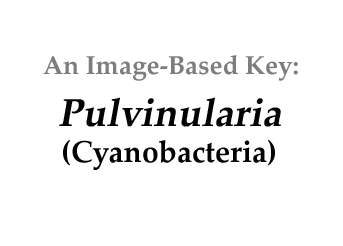|
Home / Cyanobacteria / Filaments / Branched / Pulvinularia |
||||
|
|
||||
|
Click on images for larger format |
||||
Name derivation: |
||||
|
|
||||
Classification: |
||||
|
Pulvinularia Borzi; 1 species has been described and is currently accepted taxonomically (Guiry 2016) Order Nostocales; Family Stigonemataceae or Capsosiraceae
|
||||
Morphology: |
||||
|
Highly branched trichomes usually containing thick, sometimes laminated sheaths. Heterotrichous, discoidal basal layer of cells with ‘nematoparenchymatous’ arrangement of radially filaments laterally confluent.Filaments grow from the basal disk, parallel and radially oriented, again with laterally confluent sheaths. Rare intercalary heterocysts (Branco et al. 2010). |
||||
Similar genera: |
||||
|
|
||||
Habitat: |
||||
|
Freshwater benthos, epilithic and epiphytic, apparently widespread in marshes and unpolluted running water. Reported from two lakes in Sweden and three fast-running streams in southeastern Brazil at altitudes from 990 m to 1220 m.
|
||||
References: |
||||
|
Borzì, A. (1916). Studi sulle Mixoficee. II. Stigonemaceae. Nuovo Giornale Botanico Italiano, series 2 23: 559-588. Branco, L.H.Z., L. Hoffmann, O. Necchi Jrl, S.R. Taboga and ElNlM. Moura 2010. Branch formation in Pulvinularia suecica (Nostocales, Cyanoprokaryota) and considerations on the classification of dichotomously and pseudodichotomously branched genera. Nova Hedwigia 90:95-104. Guiry, M.D. and G.M. Guiry 2016. AlgaeBase. World-wide electronic publication, National University of Ireland, Galway. http://www.algaebase.org; searched on 14 December 2012. |
||||



